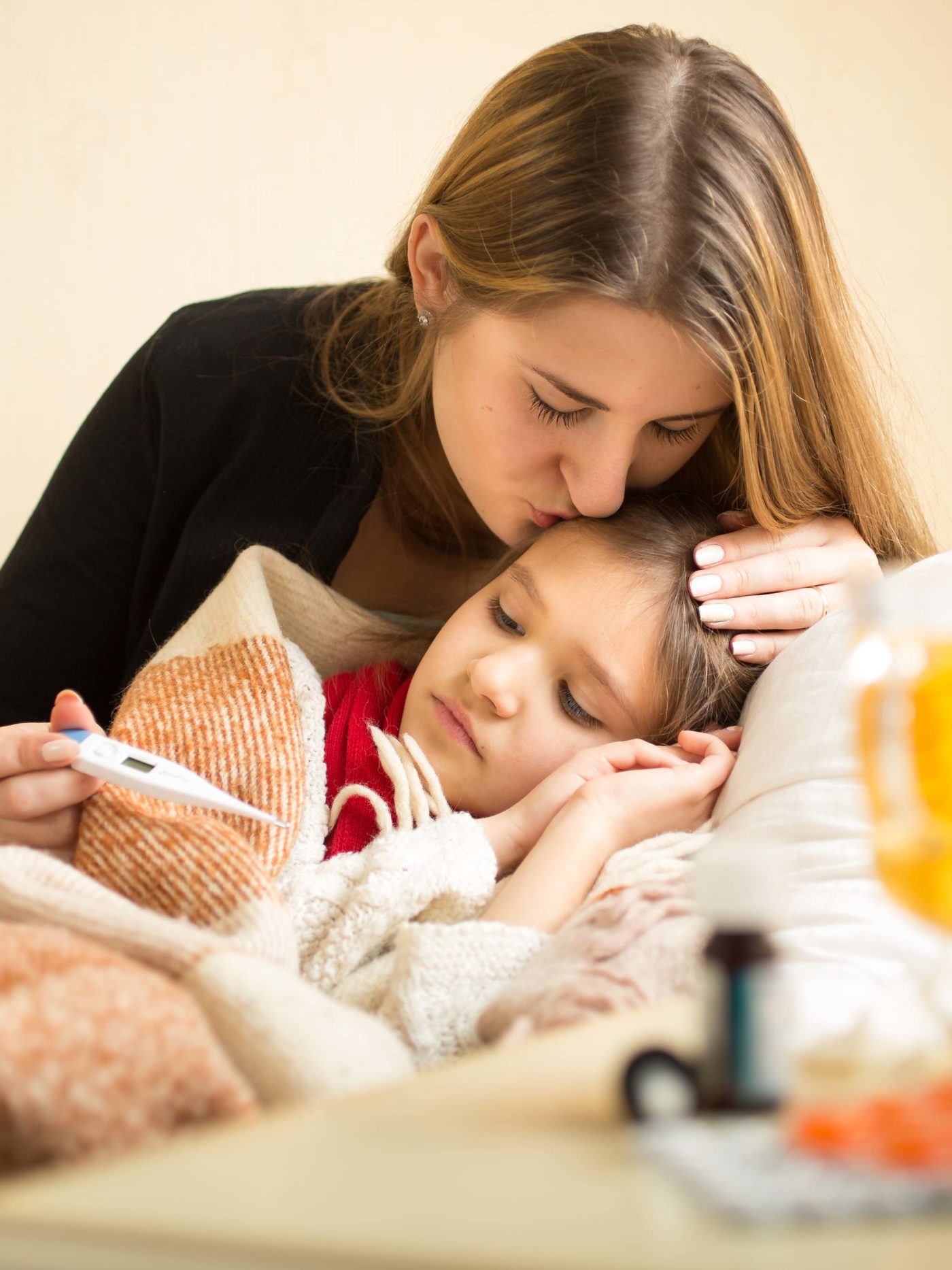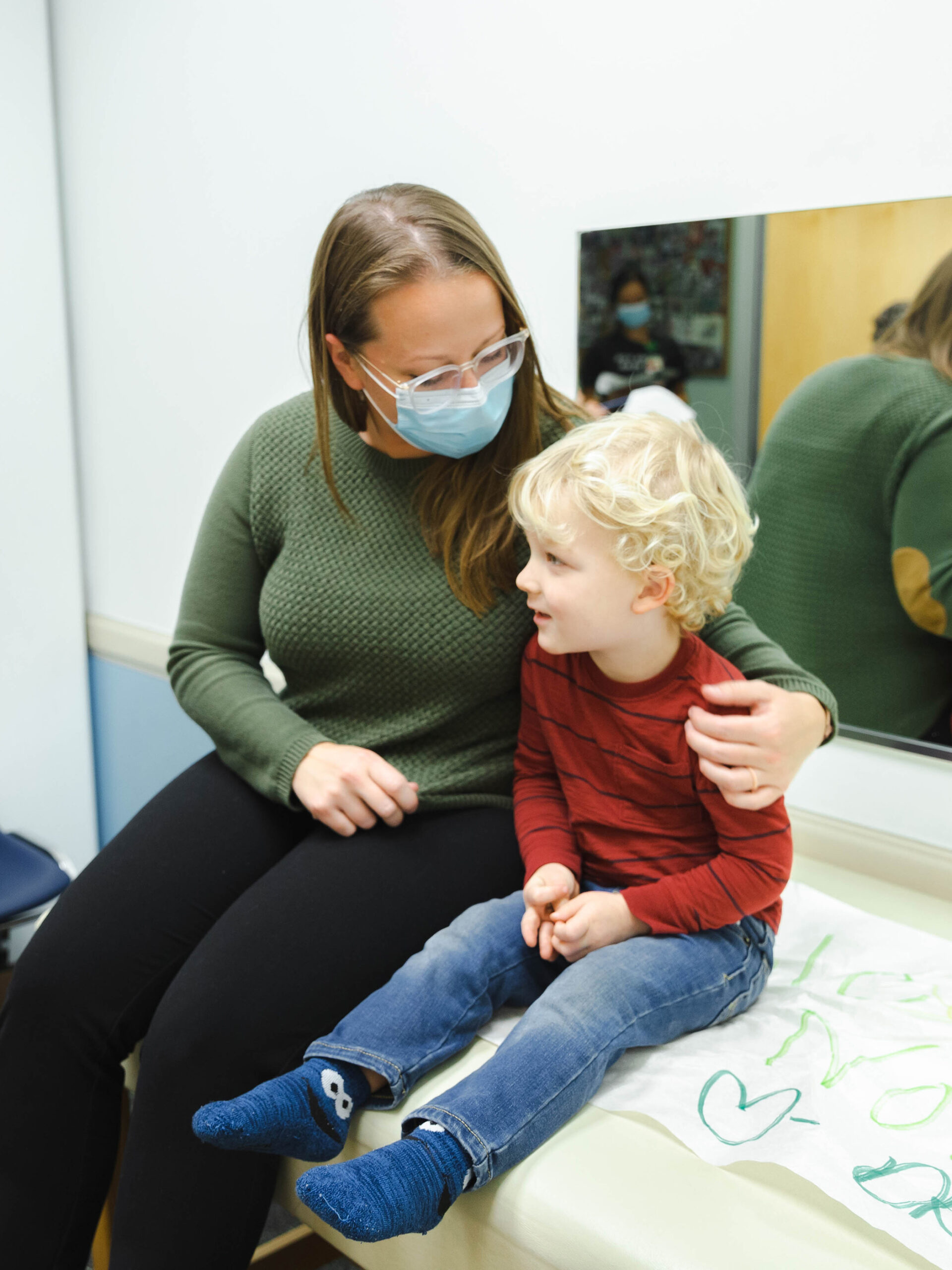Where should my child go for healthcare?
Between the pediatrician’s office and the emergency department, there are many places for kids to receive health care – and knowing where to go isn’t always clear for parents. This guide will help parents determine quickly the best choice. That way, kids can get the care they need and parents can feel confident and like the protector they are.
CARE ROADMAP
Where to go for care based on your child’s symptoms
If you think your child is experiencing a life-threatening condition or emergency, call 911 or bring them to the nearest emergency department. Do not deliberate about which diagnoses are treated at the emergency department, just get your child there.
- An infant less than 28 days old with a fever of 100.4 or more
- Weakness/numbness on one side
- Severe chest pain
- Severe difficulty breathing
- Slurred speech
- Serious burns
- Head injury
- Eye injury
- Seizure
- Severe cuts
- Bleeding that won’t stop
- Change of mental state

- Fever
- Rash
- Cough
- Wheezing
- Difficulty breathing
- Vomiting
- Diarrhea
- Sore throat
- Ear pain
- Abdominal pain
- Limb pain
- Painful urination
- Injuries: sprains, strains, simple cuts that may need stitches, bruises
- Allergic reactions

Call primary care doctor or specialist
If unavailable:
Call nurse line or triage phone number
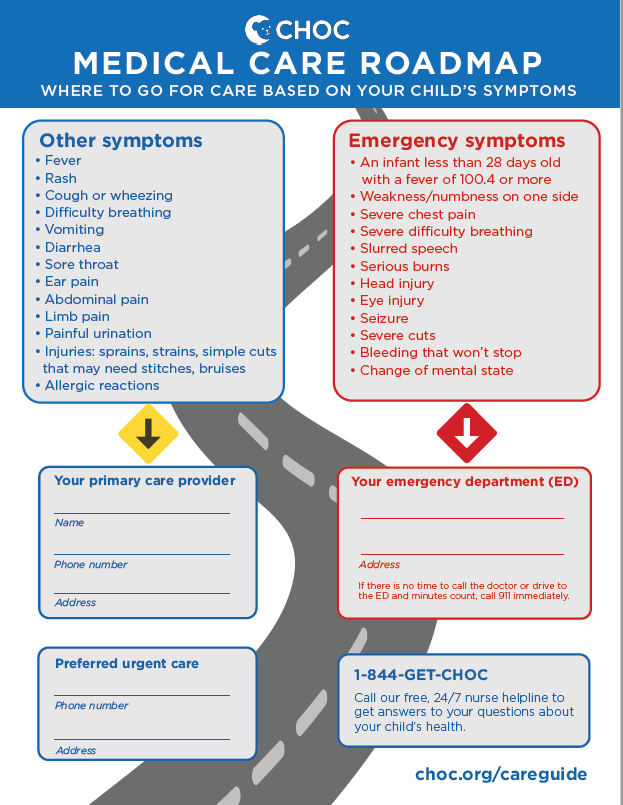
Print the guide
Print and fill out this kids’ medical care roadmap so you’ll have the phone numbers and locations for your child’s healthcare options ready when you need them. Remember to update your list when you move or change insurance coverage.
Call Nurse Line, Triage Phone Number or Primary Care Doctor
These groups can provide expert advice and provide direction for care after typical business hours.
- Most primary care offices will have an on-call physician who can provide guidance after typical business hours. Call the office to be connected with this physician.
- Many health insurance providers offer a nurse advice line. This expert can provide guidance and direct you where to go for care. Look on the back of your insurance card or on the carrier’s website for this phone number.
- These experts can help you make a determination if emergency care is warranted or if the ailment can wait until business hours resume. If the latter, they can also provide interim care guidance.
Call CHOC’s free 24/7 Nurse Advice Line
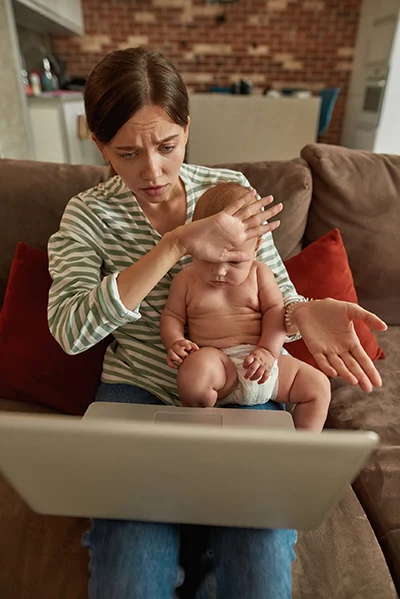
CHOC Primary Care Options in Southern California
Primary care doctor or
specialist (for chronic conditions)
Any complaint that is not an emergency can and should be assessed at your primary care doctor’s office if possible.
Your pediatrician is your primary resource for sick visits. Your child’s pediatrician or specialist (for ongoing conditions) is the doctor who already knows your child’s medical history best. This helps provide ongoing care and find a pattern in the symptoms.
You will need to set an appointment for a sick visit. Most doctor’s offices leave room in their schedule to accommodate patients who require same-day sick appointments.
Some possible reasons to go to primary care
- Fever
- Rash
- Cough
- Wheezing
- Difficulty breathing
- Vomiting
- Diarrhea
- Sore throat
- Ear pain
- Abdominal pain
- Limb pain
- Painful urination
- Injuries: sprains, strains, simple cuts that may need stitches, bruises
- Allergic reactions

CHOC Primary Care Options in Southern California
Urgent Care
Urgent care is a good option if the concern is not life-threatening or risking disability, your regular doctor is unavailable and you can’t wait for an appointment. Urgent care offices are usually open later than typical business hours, such as after 5 p.m. and on weekends. Most are walk-in clinics and do not take appointments.
Sometimes an urgent care medical professional may decide your child is too ill to go home and they may send you to the emergency department for further treatment or testing.
Some possible reasons to go to urgent care
- Fever
- Rash
- Cough
- Wheezing
- Difficulty breathing
- Vomiting
- Diarrhea
- Sore throat
- Ear pain
- Abdominal pain
- Limb pain
- Painful urination
- Injuries: sprains, strains, simple cuts that may need stitches, bruises
- Allergic reactions

CHOC Urgent Care Options in Southern California
X-ray services are available in most CHOC urgent care locations, and splinting can be done when necessary.
Emergency Department (ED) /
Emergency Room (ER)
If you think your child is experiencing a life-threatening condition or emergency, call 911 or bring them to the nearest emergency department. Do not deliberate about which diagnoses are treated at the ED, just get your child there.
Emergency departments are equipped and staffed for the most complex or critical needs, including life- and limb-threatening situations ranging from stroke to traumatic injuries following a car accident.
Some examples of possible medical emergencies
- An infant less than 28 days old with a fever of 100.4 or more
- Weakness/numbness on one side
- Severe chest pain
- Severe difficulty breathing
- Slurred speech
- Serious burns
- Head injury
- Eye injury
- Seizure
- Severe cuts
- Bleeding that won’t stop
- Change of mental state
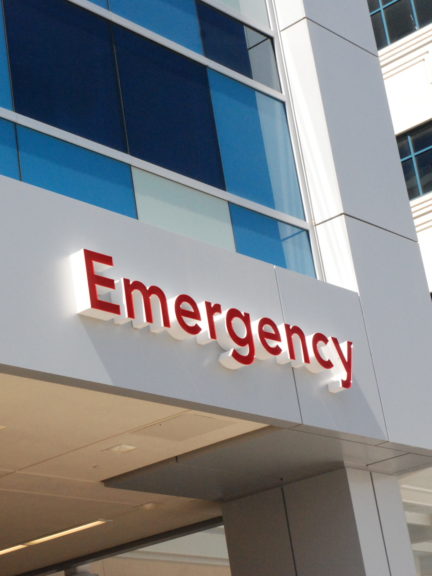
CHOC Emergency Care Options in Southern California

CHOC Hospital
Julia and George Argyros
Emergency Department
1201 W. La Veta Ave
Orange, CA 92868

CHOC at Mission Hospital
Mission Viejo
Emergency Department
27700 Medical Center Rd.
Mission Viejo, CA 92691
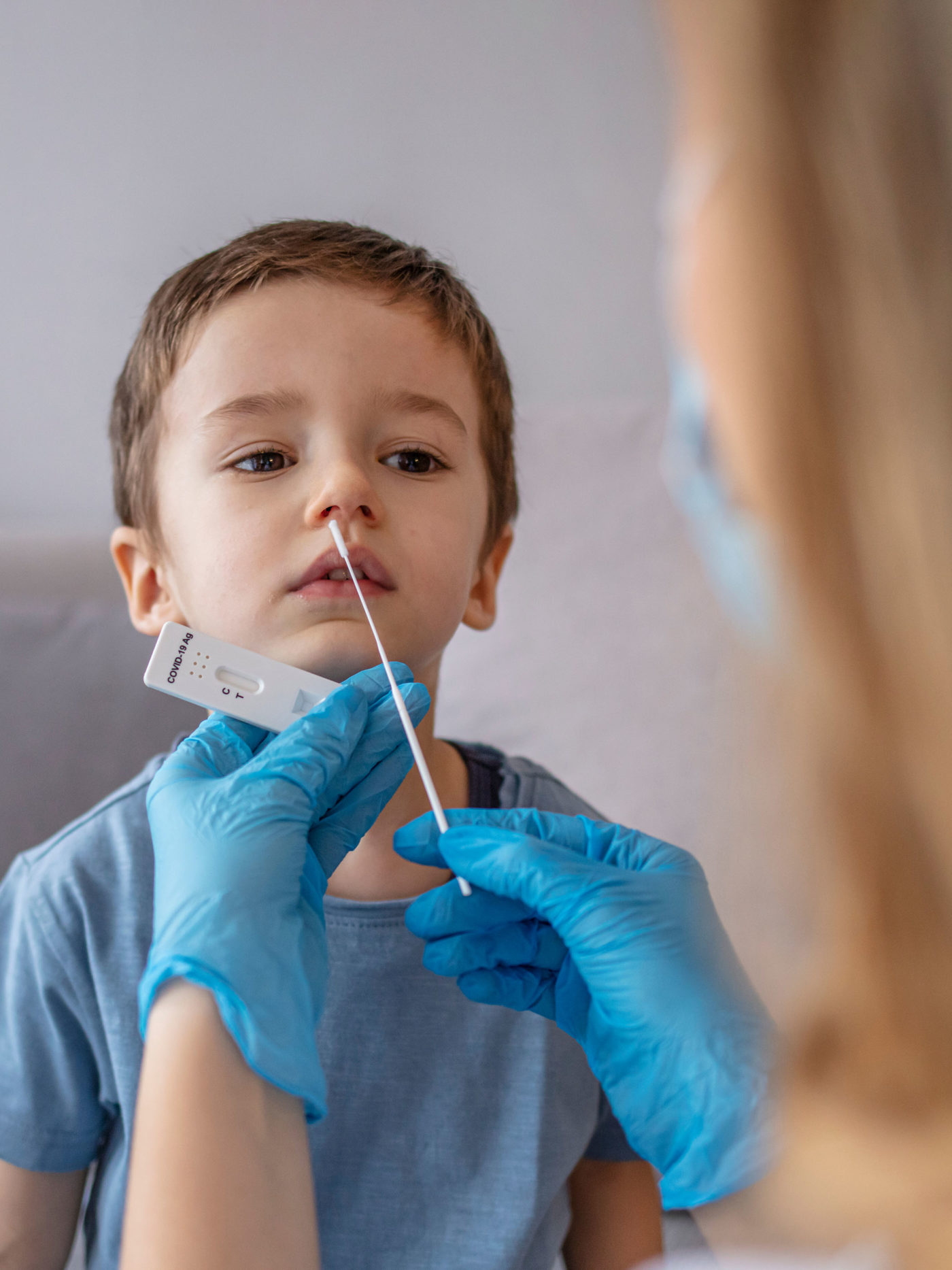
What parents should know about going to the emergency department during flu season or the COVID-19 pandemic
Due to the flu season and ongoing pandemic emergency departments nationwide are seeing an influx of patients. Similarly, CHOC is seeing an extremely high number of patients, from infants to teens, in their two pediatric emergency departments, as well as contending with staffing changes due to the pandemic.
Our physicians and staff understand how anxious and scared parents and children can get when faced with a trip to the emergency department. They offer the following information and tips for parents coming to the emergency department during the busy season:
- Be prepared to see a full lobby, including people seated in chairs down hallways and in additional areas throughout the department. Typically, the department gets busier as the day progresses.
- Leave siblings and other family members at home, if possible. This will help ease crowding, but more importantly, keeps well children from being exposed to sick ones. Also, parents’ attention should be focused on their ill or injured children.
- Patients are seen based on how sick or injured they are, not on the order they arrived in the emergency department. Please keep in mind there are patients who arrive in ambulances – admitted in an area beyond your view. Our staff must treat the sickest first. If you’ve been waiting and are concerned your child’s condition is getting worse, please ask a nurse to reassess her.
- Hold off on giving food or drink to your child until she’s been seen by the doctor. A full stomach can delay procedures and the use of sedatives.
- Don’t expect a prescription for antibiotics, which aren’t always the answer. Antibiotics can only treat infections caused by bacteria. Cold illness caused by viruses can’t be cured with an antibiotic.
- Try to stay calm. Children can pick up on their parents’ fear and anxiety. Take deep breaths for your and your child’s sake.
We kindly ask that you do not come to the emergency department at CHOC for return-to-school COVID-19 testing if your child is not ill at this time. You can find information about local testing resources here. Be sure to check with your child’s school or district for their specific guidelines.

Why should I go to a pediatric emergency department/urgent care instead of one for adults?
Not all urgent care clinics and emergency rooms take care of children on a regular basis. Pediatric-focused facilities have specialized training and equipment to offer the best care for your child.
Children are not miniature adults, and it’s not simply a matter of ordering smaller blood pressure cuffs. Children and teens are physiologically different and experience different symptoms when compared to adults. A high fever, stomachache or other mysterious aches and pains that would not to appear be serious in an adult can, in fact, be dire for children. When in doubt, it’s always best to let the experts decide. And no one knows more about babies, kids and teens than pediatric professionals.
Pediatric-focused facilities often offer services you won’t find at regular hospitals, like child life specialists. These trained child development professionals are experts at providing comfort to patients and families. They can help explain procedures or ailments in a way that is easy for children – and their parents — to understand. They also provide distractions to help alleviate pain, minimize anxiety or pass the time.

What to bring with you
Whether you’re visiting your child’s regular pediatrician or rushing out the door to go to urgent care or the emergency department, bring the following items with you for an easier visit.
- Insurance card + identification
- List of medications the child is taking
- Paperwork or test results if your child has been seen somewhere else
- Diapers, formula and other baby supplies such as a blanket and pacifier
- A favorite stuffed animal that can be “examined” by the doctor if your child is nervous about the visit
- A favorite book, game or tablet to keep your child occupied if there is a wait
- Water
For visits with your child’s primary care doctor, you may also bring
- School paperwork if your appointment is tied to a physical for school activities
- List of questions you and your family may have
Parents are encouraged to try and make childcare arrangements for other children, especially during flu season. To avoid delaying potential testing, parents are not encouraged to give their child a snack or drink while waiting to be seen.
Did you know not all fevers are emergencies?
Learn how to tell when your child’s fever is an emergency and when it isn’t.
Related Articles
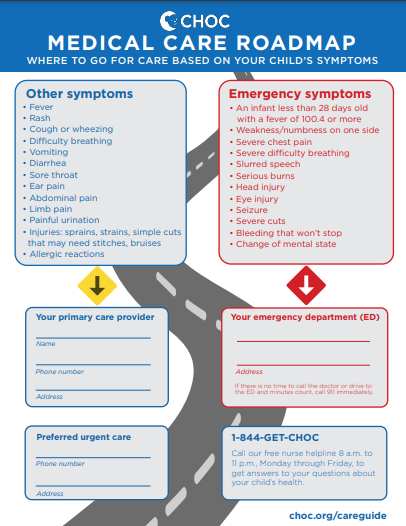
Print the guide
Print and fill out this kids’ medical care roadmap so you’ll have the phone numbers and locations for your child’s healthcare options ready when you need them. Remember to update your list when you move or change insurance coverage.

